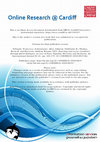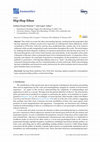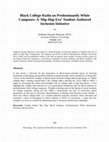Books by Anthony Kwame Harrison
Race in the Marketplace: Crossing Critical Boundaries, 2019
In his fable "The Racial Preference Licensing Act," the late Harvard law professor Derrick Bell (... more In his fable "The Racial Preference Licensing Act," the late Harvard law professor Derrick Bell (1992) imagines a license which authorizes businesses to exclude people on the basis of their race. Similar to pollution permits giving firms the legal right to pollute, this license legalizes racial discrimination for a fee ("expensive though not prohibitively so," p. 48). Once obtained, a business must display their license prominently within their premises and operate their activity in accordance with their official racial preference. Only licensed facilities are allowed to discriminate. Others, if found

Ethnography, 2018
This book familiarizes readers to ethnographic research and writing traditions through detailed d... more This book familiarizes readers to ethnographic research and writing traditions through detailed discussions of ethnography’s history, exploratory design, representational conventions, and standards of evaluation. Responding to the proliferation of ethnography both within and outside of academe, it grounds ethnographic practices within the anthropological principles of cultural awareness, thick description, and embodied understanding. At the same time, it introduces new frameworks for grasping ethnography’s simultaneous strategic and improvisational imperatives, as well as for appreciating its experimental conventions of social-science/humanistic research reporting. Central to this process, the book introduces the concept of ethnographic comportment—defined as an historically informed politics of position that impacts ethnographers’ conduct and disposition—which serves as a standard for gauging and engaging ethnography throughout the text. Part research primer, writing guide, and assessment handbook, Ethnography (Understanding Qualitative Research) provides a comprehensive introduction to one of the richest and most expansive traditions of qualitative research.
Papers by Anthony Kwame Harrison
IASPM@journal, Jul 27, 2023
HAL (Le Centre pour la Communication Scientifique Directe), 2021
Advertising & Society Quarterly

Ecozon@: European Journal of Literature, Culture and Environment
In this autobiographical piece, I reflect on my twenty-year history as an emcee working at the in... more In this autobiographical piece, I reflect on my twenty-year history as an emcee working at the intersection of hip hop and environmental awareness. Since summer 2000, I have recorded and performed environmentally situated hip-hop music under the moniker “Mad Squirrel.” This includes co-founding two groups—the San-Francisco-based Forest Fires Collective and Washington DC’s The Acorns—as well as releasing various solo projects and taking part in a handful of performances. In what follows, I explain the origins of my nature-based performance identity by, first, recounting my experiences growing up as an avid hip-hop fan in a rural New England (USA) mountain village and, then, expounding on how Mad Squirrel’s forest narratives marked a return to the Black diasporic tradition of animal stories that align with my West African heritage. I go on to describe how this identity and approach became the springboard for a small circle of Bay Area artists to produce a series of critically heralded...
Annals of Tourism Research
California western law review, 2021

Equity, Diversity and Inclusion -- An International Journal, 2020
PurposeGrounded in experience of co-organizing a two-day photography-based workshop in Paris, thi... more PurposeGrounded in experience of co-organizing a two-day photography-based workshop in Paris, this paper explores how photo-dialogues can facilitate anti-racist pedagogy and generative discussions about how race and racism function in marketplace contexts.Design/methodology/approachThis paper draws on the authors' involvement in a cross-national and cross-disciplinary team of scholars who worked with local community stakeholders—including activists, artists and practitioners—to discuss, theorize and photo-document issues regarding race and racism in the Parisian marketplace.FindingsThis paper contributes to the literature on visual culture studies and critical race studies as it demonstrates the potentials of photography combined with dialogue to challenge the White supremacy over archiving and visuality in the context of urban spaces. This new methodology is an opportunity to reflect on archetypes of visuality that depart from the traditional Parisian flâneur to be consistent w...
Shuddhashar (শুদ্ধস্বর), 2021
Zines: An International journal on Amateur and DIY Media , 2020
General Anthropology, 2020

Humanities, 2019
This article excavates the ethos surrounding hip hop, starting from the proposition that hip hop ... more This article excavates the ethos surrounding hip hop, starting from the proposition that hip hop represents a distinct yet pervasive expression of contemporary black subjectivity, which crystalized in 1970s New York City and has since proliferated into a potent ethos of the subaltern embraced within socially marginalized youth communities throughout the world. The article begins by outlining the black diasporic traditions of expressive performance that hip hop issues from, as discussed through the work of Zora Neale Hurston and Amiri Baraka. In the remainder of the article, a blueprint of hip hop's ethos is presented based on five fundamental tenets: (1) properties of flow, layering, and rupture; (2) a principle of productive consumption; (3) the production of excessive publicity or promotion-what hip-hop affiliates refer to as "hype"; (4) embracing individual and communal entrepreneurship; and (5) a committed politics of action and loyalty. While acknowledging hip hop's malleability and refusal to be neatly characterized, the article maintains that its characteristic spirit embodies these core doctrines.

In this article, I advocate for the importance of Black-music-oriented spaces in fostering sentim... more In this article, I advocate for the importance of Black-music-oriented spaces in fostering sentiments of belonging among Black students at predominantly white institutions. In doing this, I focus on the historical example of Black-music-oriented college-radio programing—or 'Black college-radio'—during a period that I call 'college radio's hip-hop era' (circa 1980 to 1993). I begin by discussing the under-acknowledged role of college radio in hip hop history. I next highlight the 'college radio hip-hop era' as a particularly tumultuous time for Black students on predominantly white college campuses. Through revisiting some of the history of racial incidents on college campuses during the late 1980s, I demonstrate the lack of conviction and/or preparation on the part of university administrations in dealing with diversity issues. Finally, I show how Black college-radio, as a student-authored inclusion initiative, both cultivated and sustained a sense of belonging for Black students at PWIs. In conclusion, I argue that this example can serve as a model for addressing today's inclusion and diversity challenges.
IASPM-US Mixtape Series, Aug 2013











Uploads
Books by Anthony Kwame Harrison
Papers by Anthony Kwame Harrison
A short introductory essay (p. 2), exploring Jackson’s unacknowledged connection to the Green Book, is partnered with a sketched landscape of roadside billboards spotlighting the three most celebrated trajectories of his varied career (cover). Each billboard features a portrait of Jackson by artist Kevin Earley. These historical foundations set the stage for various commentaries on contemporary conditions of Black travel through racialized geographies. Autoethnographic writings by Anthony Kwame Harrison (p. 4) and Corey J. Miles (p. 12) convey different 21st Century experiences of driving while black through spaces of White domination and dominion. The artistic centerpieces for the issue include a musical/lyrical essay, “White Reign,” composed by Harrison and longtime music collaborator, BlakeNine, as well as three evocative images by Virginia artist, Asa Jackson (p. 4, 8 & 11). Harrison’s autoethnographic travels take him through the all-White town of New Castle, Virginia. A return trip to New Castle, with colleague and cinematographer Karl Precoda, resulted in the short film, Sundown (p. 9). Lastly, the unsettling experience of visiting New Castle prompted Harrison to choreograph a photoshoot with photographer Richard Randolph (p. 3 & 12).
In line with DYSFUNCTION’s mission of raising critical questions about the role of arts-based research dissemination in academic spaces, this collaborative project—primarily orchestrated by Harrison around his physical and intellectual journeys to learn more about “Billboard” Jackson and the racist forces he dedicated his career to working against—challenges readers/viewers/listeners to grapple with the complexities of American racism as experienced, symbolized, and imagined by two centuries of Black travelers. These works are meant to evoke critical reflections on experiences of Black (auto)mobility that are at times jarring, at others mundane, and sometimes both simultaneously. Weaving together intricate threads of experience and (re)presentation, the showcased pieces portray a world in motion, characterized by complex transactions involving racialized histories, perceptions of place, agency, citizenship, and enduring White supremacy. The messages filtering through these mediated mindscapes are cohesive yet non-comprehensive. Their intentional incompleteness invites those who witness them to dwell in the ambiguity and to ultimately make their own personal, emotional, and intellectual connections. As an addendum to the 2019 Race in the Marketplace (RIM) Research Forum, this issue of DYSFUNCTION opens up space for dialogue by foregrounding complex processes of meaning-making surrounding the relationship between racial identities, structures of power and oppression, and markets.
To Access the Full Journal Visit: https://www.dysfunction-journal.net/post/185080763758/dysfunction-6-white-reign-an-issue-dedicated-to
animateur sur Radio 1 BBC, dans une interview menée en 1987. Formé en 1983, le groupe composé de cinq frères et soeurs enchaîne les succès en Grande-Bretagne entre 1985 et 1987, classés à six reprises dans le top 10 des meilleures ventes, avant de recevoir en 1987 le prestigieux Brit Award du meilleur groupe britannique, en grande partie grâce au succès de leur
deuxième album Silk and Steel. Mais leur quatrième album, Rock the World, sorti en août 1988, voit sa chanson la mieux classée n’atteindre qu’une modeste 49e place dans le Single Chart britannique, amorçant le déclin dramatique de Five Star. Le groupe ne parviendra jamais à percer
sur le marché américain – sa meilleure chanson au Billboard Hot 100, le single de 1986 intitulé « Can’t Wait Another Minute », ne se hisse qu’à la 41e position – et restera pratiquement inconnu de la plupart des amateurs de musique américains. En associant une sociologie des organisations
fondée sur la production de la culture, avec un examen musicologique de l’histoire et de la définition des frontières des genres musicaux, et une évaluation critique de la façon dont l’identité britannique noire du groupe a été présentée et reçue, cet article montre comment la visibilité éphémère de Five Star au Royaume-Uni, et son invisibilité aux États-Unis, ont peu à voir avec la qualité de leur musique, mais doivent être attribuées aux politiques de l’industrie et aux impacts transnationaux des notions dominantes de race, de genre et d’authenticité sur la réception de la musique populaire.